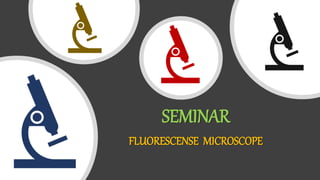
Fluorescence Microscope Seminar
- 2. FLUORESCENCE MICROSCOPE DEFINITION : A Fluorescence microscope is an optical microscope that uses fluorescence and phosphorescence instead of ,or in addition to, reflection and absorption to study properties of organic or inorganic substances. Fluorescence is the emission of light by a substance that has absorbed light or other electromagnetic radiation. Phosphorescence is a specific type of photoluminescence related to fluorescence. Unlike fluorescence, a [phosphorescent material does not immediately re-emit the radiation it absorbs.
- 3. DISCOVERY OF FLUORESCENCE MICROSCOPE • British scientist Sir George G. Stokes first described fluorescence in 1852. • He observed that the mineral fluoro-spark emitted red light when it was illuminated by ultraviolet excitation. • Stokes noted that fluorescence emission always occurred at a longer wavelength than of the excitation light. • On 8th October 2014, the Nobel Prize in chemistry was awarded to awarded to Eric Betzig, William Moerner and Stefan Hell for, which brings “ optical microscopy into the nano dimension”.
- 5. PRINCIPLE • The specimen is illuminated with light of a specific wavelength (or wavelengths) which is absorbed by the fluorophores, causing them to emit light of longer wavelengths (i.e., of a different color than the absorbed light). The illumination light is separated from the much weaker emitted fluorescence through the use of a spectral emission filter. Typical components of a fluorescence microscope are a light source (xenon arc lamp or mercury-vapor lamp are common; more advanced forms are high- power LEDs and lasers), the excitation filter, the dichroic mirror (or dichroic beam splitter), and the emission filter (see figure below).
- 6. • The filters and the dichroic beam splitter are chosen to match the spectral excitation and emission characteristics of the fluorophore used to label the specimen. In this manner, the distribution of a single fluorophore (color) is imaged at a time. Multi-color images of several types of fluorophores must be composed by combining several single-color images.Most fluorescence microscopes in use are epifluorescence microscopes, where excitation of the fluorophore and detection of the fluorescence are done through the same light path (i.e. through the objective). These microscopes are widely used in biology and are the basis for more advanced microscope designs, such as the confocal microscope and the total internal reflection fluorescence microscope (TIRF).
- 9. PARTS OF FLUORESCENCE MICROSCOPE • Fluorescent dyes (Fluorophore) • A fluorophore is a fluorescent chemical compound that can re-emit light upon light excitation. • Fluorophores typically contain several combined aromatic groups, or plane or cyclic molecules with several π bonds. • Many fluorescent stains have been designed for a range of biological molecules. • Some of these are small molecules that are intrinsically fluorescent and bind a biological molecule of interest. Major examples of these are nucleic acid stains like DAPI and Hoechst, phalloidin which is used to stain actin fibers in mammalian cells. • A light source • Four main types of light sources are used, including xenon arc lamps or mercury-vapor lamps with an excitation filter, lasers, and high- power LEDs. • Lasers are mostly used for complex fluorescence microscopy techniques, while xenon lamps, and mercury lamps, and LEDs with a dichroic excitation filter are commonly used for wide-field epifluorescence microscopes.
- 10. • The excitation filter • The exciter is typically a bandpass filter that passes only the wavelengths absorbed by the fluorophore, thus minimizing the excitation of other sources of fluorescence and blocking excitation light in the fluorescence emission band. • The dichroic mirror • A dichroic filter or thin-film filter is a very accurate color filter used to selectively pass light of a small range of colors while reflecting other colors. • The emission filter. • The emitter is typically a bandpass filter that passes only the wavelengths emitted by the fluorophore and blocks all undesired light outside this band – especially the excitation light. • By blocking unwanted excitation energy (including UV and IR) or sample and system autofluorescence, optical filters ensure the darkest background.
- 12. APPLICATION These microscopes are often used for Imaging structural components of small specimens, such as cells Conducting viability studies on cell populations (are they alive or dead?) Imaging the genetic material within a cell (DNA and RNA) Viewing specific cells within a larger population with techniques such as FISH .
- 13. ADVANTAGE 1.Fluorescence microscopy is the most popular method for studying the dynamic behavior exhibited in live-cell imaging. 2.This stems from its ability to isolate individual proteins with a high degree of specificity amidst non-fluorescing material. 3.The sensitivity is high enough to detect as few as 50 molecules per cubic micrometer. 4.Different molecules can now be stained with different colors, allowing multiple types of the molecule to be tracked simultaneously. 5.These factors combine to give fluorescence microscopy a clear advantage over other optical imaging techniques, for both in vitro and in vivo imaging.
- 14. LIMITATION • Fluorophores lose their ability to fluoresce as they are illuminated in a process called photobleaching. Photobleaching occurs as the fluorescent molecules accumulate chemical damage from the electrons excited during fluorescence. Photobleaching can severely limit the time over which a sample can be observed by fluorescence microscopy. Several techniques exist to reduce photobleaching such as the use of more robust fluorophores, by minimizing illumination, or by using photoprotective scavenger chemicals. • Fluorescence microscopy with fluorescent reporter proteins has enabled analysis of live cells by fluorescence microscopy, however cells are susceptible to phototoxicity, particularly with short wavelength light. Furthermore, fluorescent molecules have a tendency to generate reactive chemical species when under illumination which enhances the phototoxic effect.
- 15. BIO TECH YOUNG SCIENTISTS G.GNANA ABISHEK - A10UBT027 M.GOKULA MAHESHWARAN - A10UBT028 J.JAYA SURIAN - A10UBT029 M.MAHARAGAVAN - A10UBTO30 M.MAREESWARAN - A10UBT031 M.MUTHU MANI KANDAN - A10UBT032 P.NAGESWAR - A10UBT033 THANK YOU
